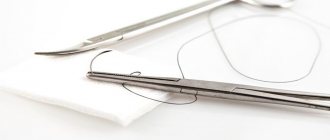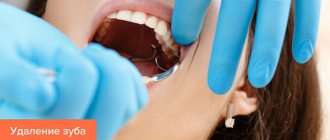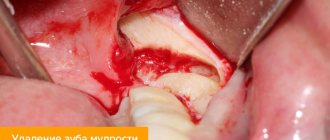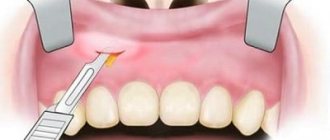At the same time, even in cases where a person shows high responsibility towards his health, it may be necessary to remove a tooth. First of all, this concerns wisdom teeth. In addition to the fact that the procedure itself is often painful, due to the peculiarities of their location, as well as the different age of complete eruption, the removal of wisdom teeth can be accompanied by unpleasant complications. However, by entrusting the procedure to a qualified specialist, you can be sure of a positive outcome. However, in order to avoid problems during the healing process of the gums, you should strictly follow all the doctor’s recommendations for hygienic treatment of the oral cavity.
Painless tooth extraction in Moscow - Selin aesthetic dentistry clinic
Wisdom teeth and features of their eruption
The third molar (molar) is more often called a wisdom tooth or “figure eight” (the third molar is the 8th from the middle of the dentition). It is not preceded by a milk tooth, and the formation does not occur in the prenatal period, but at the age of 3–5 years. The “eight” erupts later than others, when the jaw bones have completely or partially stopped growing at the age of 14 to 30 years, sometimes even later. Growth and eruption completely depend on the hereditary characteristics of the organism.
Location of wisdom teeth
The crown of the third molar is no different in appearance from adjacent crowns. The main features are in the structure of the roots and root canals. As a rule, there are several channels. They are tortuous, narrow and are not always located in a separate root. The norm is 2–3 roots, but sometimes there are more roots, fewer, or only one, and several canals can be seen in it. This makes it very difficult to treat caries.
By the time the third molar erupts, the jaw bones in most cases have already finished growing, so it often does not have a place in the dentition, which means that eruption occurs incorrectly. This condition is called dystopia. Normally, the “figure eight” should erupt vertically and correspond in height to the rest of the crowns, but a dystopic tooth, trying to erupt, changes its position and can be located:
- vertically, but significantly lower (sometimes higher) than the rest of the teeth in the row;
- horizontally - if growth goes towards the neighboring tooth, its root suffers; when growing forward or backward, soft tissues are injured;
- diagonally (beveled, at an angle) - both the root and the crown of the adjacent tooth may be damaged;
- turning around its axis - tortoposition;
- in place of another tooth - transposition.
Sometimes the “eight” does not erupt at all. If at the same time a person does not have any complaints and the rudiments of it are not visible on the x-ray, then this is a variant of the norm. But when the “eight” does not erupt completely or does not erupt at all, which is accompanied by swelling and pain, then this is no longer the norm. An impacted tooth is:
- completely unerupted, covered on top with bone tissue of the jaw or gum;
- partially cut through, but covered with a hood on top, through which part of the crown can be seen.
- Third molars are often both dystopic and impacted.
How is tooth extraction performed?
It all starts with a consultation. The doctor will take a three-dimensional photograph, assess the location of the tooth in the jaw, the number and direction of the roots - wisdom teeth are famous for their unusual anatomy. All other human teeth are classified and have their own standard structure options, while the shape of wisdom teeth is random.
By the way, why wisdom? The point is the timing of the formation of tooth germs. All other teeth are formed in utero and after birth only continue their development and eruption. The formation of figure eights in the jaws occurs at the age of 4-5 years, and the beginning of teething occurs at an older age, hence the connection with wisdom.
After assessing the situation based on the image, you will be scheduled for surgery. At the appointment, the doctor administers anesthesia and removes the tooth. Most often, you need to make a small incision in the gum and cut the tooth into several parts; you can read more in detail here.
After removal, the additional incision is sutured, but the hole itself remains. The doctor inserts a membrane made from the patient’s venous blood into it - before the operation begins, the blood is taken and the tube is sent to a centrifuge, where the membrane is formed. Experience has shown that this will heal better and faster. A blood clot forms in the hole with the membrane, through which it will heal.
When should wisdom teeth be removed?
A normally erupted third molar that performs all its functions does not need to be removed; in the future, it can become a support for a fixed prosthesis. If a wisdom tooth hurts, removal occurs only according to indications and after an examination. Indications for removal are, first of all, pain and discomfort that the patient experiences during eruption. With these symptoms, he turns to the dentist, and he decides what exactly needs to be done after examination and x-rays. “Eight” is removed if there is:
- deep caries, which cannot be treated for some reason, mainly due to inaccessibility or obstruction of the root canals (they are often narrow and tortuous);
- pericoronitis (pericoronitis) - inflammation of the gum (hood) covering the erupting molar;
- retention - the “figure eight” cannot break through the bone tissue, which leads to the development of infectious and inflammatory processes in the soft tissues and tissue of the jaw;
- dystopia - growth is not directed vertically, but to the side, which leads to injury to surrounding tissues, disruption of the bite and growth of other teeth in the dentition due to the lack of space necessary for this (the second molar may especially suffer);
- the need to install braces in case of abnormal growth or crowding of teeth in the dentition - third molars can disrupt this process;
- pinching of the branches of the trigeminal nerve, accompanied by attacks of severe pain or discomfort (paresthesia).
Sometimes abnormal growth of the third molar is detected even before the patient complains. In such cases, the dentist also recommends its removal.
Infectious and inflammatory processes during teething
The growth and eruption of the third molar is often accompanied by infectious and inflammatory processes of the surrounding soft tissues. This is due to the fact that the “figure eight” often begins to erupt under the hood – the gum covering it. An infection penetrates under the hood and an inflammatory process develops. The course can be acute or chronic, inflammation - catarrhal, purulent or ulcerative. Symptoms of pericoronitis:
- unpleasant sensations in the eruption zone - discomfort, itching, pain;
- putrid odor from the mouth;
- swelling of the tissues, pain when chewing, sometimes convulsive spasm of the jaws (trismus);
- increased body temperature (not always);
- enlargement and tenderness of the submandibular and cervical lymph nodes.
If you suspect improper eruption and inflammation of the gums, it is better to immediately consult a dentist without waiting for serious complications. Depending on the existing pathology, the dentist may prescribe therapeutic treatment and remove the hood or tooth.
Irregular growth of wisdom teeth
When you need to see a doctor urgently
Some patients hope until the last moment that “this will pass” and do not contact a specialist in a timely manner. The consequences of this tactic can be serious: the infection will spread like fire to surrounding tissues. You should consult a doctor urgently if the following symptoms appear:
- increased pain and discharge of pus;
- the appearance of fever;
- significant swelling of the mucous membrane in the oral cavity, spreading to the surrounding tissues - the cheek swells, which is already noticeable from the outside;
- destruction of the “eight” by caries – painful reactions to cold, hot, sour, sweet foods;
- painful enlargement of the submandibular lymph nodes.
The appearance of such symptoms indicates that a complication is beginning and specialist intervention is required.
How to prepare for removal
If the process of the emergence of the third molar causes concern or is accompanied by pain, then it is necessary to show the problem unit to the dentist as soon as possible. You should not postpone a visit to the clinic, abuse painkillers or use “miracle” folk remedies - this will not help solve the problem and may worsen it.
After treatment, there are 2 possible scenarios - the wisdom tooth will be treated or removed. To properly prepare for removal, just follow a few simple recommendations.
- 1 - 2 days before the procedure, stop taking alcohol and anticoagulants - drugs that impair blood clotting, for example, Aspirin, Heparin, Ibuprofen.
- On the eve of the operation, it is better not to practice warming procedures - go to the bathhouse, sauna, solarium, or steam your feet.
- Be sure to eat 1 – 2 hours before removal.
- Before visiting a doctor, thoroughly brush your teeth and mouth with a regular toothbrush and toothpaste.
Immediately before removing a wisdom tooth, it is recommended to lubricate your lips with Vaseline or hygienic lipstick - this will protect them from the formation of cracks. As a rule, in good clinics the dentists do this themselves, but just in case, it is better to take the product with you from home.
It is important to know! According to the observations of dentists, seeking help earlier guarantees a less painful procedure.
This is due to the fact that the place where the figure eight appears is not yet “exhausted” by pain, slightly inflamed, without swelling and other unpleasant symptoms. In this case, an injection of anesthesia will be sufficient to completely numb the procedure.
If you endured it for a long time, took pills, and then couldn’t stand the torment and asked for help, then you need to be prepared for the fact that, most likely, the operation will be more painful and the dentist will have to use a larger dose of anesthesia, which is not always possible.
Regardless of the time of treatment, it is necessary to understand that figure eight extraction is a rather complex process from a technical point of view, requiring the efforts of a doctor. Naturally, tooth extraction will be accompanied by unpleasant sensations. The degree of their manifestation depends on the patient’s pain threshold - therefore it is better to warn the specialist in advance about the characteristics of your body.
Wisdom tooth removal procedure
The third molar is removed strictly according to indications. An experienced doctor will perform the operation absolutely painlessly. If it's a simple removal, it will only take a few minutes. If it is complex, the operation will be longer (depending on the existing problem), but also painless. In this situation, professionalism is required from the doctor, and a positive attitude and calmness from the patient.
Exploratory survey
Before removing the third molar, the doctor carefully examines the patient, prescribes an additional examination (x-ray of the jaw) and only then decides on further treatment tactics. At the same time, the issue of pain relief is resolved.
Preparing for surgery
Before removing the “eight”, the doctor must treat acute purulent-inflammatory processes. After this, he sets the date for the operation and explains to the patient that immediately before the operation it is necessary:
- eat - dentists do not recommend performing surgery on an empty stomach;
- brush your teeth using a toothbrush and floss; rinse your mouth with an antiseptic;
- calm down, if necessary, take a sedative of natural origin: a tablet of valerian extract, Novo-Passita, motherwort infusion or something else;
- Tell your doctor if you are allergic to any medications, what illnesses you have and what medications you take regularly (after taking some medications, surgery cannot be performed).
It is forbidden:
- drink alcohol, drugs, and pills with psychoactive effects (tranquilizers, antipsychotics);
- smoking - this leads to narrowing of blood vessels and slower healing after surgery;
- steam in a bathhouse or sauna - vasodilation is fraught with postoperative bleeding;
- engage in sports or heavy physical work.
What tools are needed?
Set of elevators and forceps for wisdom tooth removal
To carry out the operation you will need:
- syringe for anesthesia;
- scalpel - for cutting the gums (not always required);
- elevator - a tool that lifts the tooth root and removes it from the cell;
- forceps – grab the dental crown and remove it along with the root in a simple operation;
- drill – necessary for complex molar removal; it is cut and removed piece by piece.
Simple wisdom tooth removal
This operation is possible if:
- the presence of one or more even roots on the third molar;
- not destroyed crown;
- absence of dystopia and retention.
The doctor administers local anesthesia (infiltration or conduction). After 5 minutes, when the patient feels numbness of the tissues, the gum is pushed back in the neck of the third molar, the root is lifted with an elevator, and if necessary, forceps are used to grasp and extract the inverted tooth. Sometimes only forceps are used for removal. After the wisdom tooth is removed, the hole is treated with an antiseptic and the bleeding is stopped. If necessary, if the hole is large, 1–2 sutures are applied.
Complex wisdom tooth removal
Complex tooth extraction
This type of surgical intervention is used if the “eight” has:
- several curved roots;
- there is dystopia or retention; it cannot be removed in a simple way;
- The dental crown is completely destroyed.
Anesthesia during such an operation can be combined (a combination of infiltrative and conductive). Patients with increased sensitivity to pain are first given topical anesthesia - an anesthetic gel is applied to the gums.
The surgeon uses a scalpel to cut the gum, providing access to the root. Using a drill, the crown and root are cut into several parts and removed using forceps. The resulting wound is washed with an antiseptic, an anti-inflammatory agent and sutures are applied. In case of complex removal of the “eight”, antibacterial therapy is also necessary, but only the attending physician can prescribe it. Sutures made from absorbable material at the site of the extracted tooth are not removed; sutures made from non-absorbable material are removed after a week.
A few words about coffee
Coffee is the favorite drink of many of us. That is why it is worth talking in more detail about whether coffee can be consumed after wisdom tooth removal.
A cup of this aromatic drink helps to calm down and get into the usual mood, but you can drink it only a few hours after this dental operation. It is necessary to wait until a stable blood clot forms and the wound closes. This happens approximately three hours after removal.
This limitation is due to the effect of caffeine on the body:
- narrowing of blood vessels. Under the influence of caffeine, bleeding may increase, which will slow down the process of closing the wound;
- increased blood pressure;
- increased acidity in the stomach. Drinking the drink on an empty stomach can result in heartburn and nausea.
But even after several hours have passed, you should follow some rules for drinking coffee. First of all, you should remember that doctors prohibit eating hot food, so the temperature of the drink should not exceed 35o C.
You should not drink strong coffee; add milk or cream to it, and the drink itself must be filtered first. Coffee grounds contain the highest amount of caffeine, which will make you feel hungry. Refrain from adding your favorite spices to the drink.
You should drink coffee carefully not only after tooth extraction, but also before this operation. The fact is that caffeine reduces the body's sensitivity to anesthesia.
Features of wisdom tooth removal in the upper and lower jaws
The upper jaw has relatively thin and porous bone tissue, while the lower jaw has much denser bone tissue. Therefore, to remove the upper “eights”, it is sufficient to inject an anesthetic into the gum near the diseased tooth (infiltration anesthesia). When removing a lower wisdom tooth, conduction anesthesia is usually used - the injection is made at the exit point of the nerve innervating this area.
It is easier to remove third molars from above than from below, but if the root breaks off, it is more difficult to remove it in the upper jaw due to limited access to the operation site.
Removal steps
If the wisdom tooth has already erupted, the dentist may not carry out any preparatory procedures. If an unerupted or partially erupted “figure eight” is to be removed, the doctor will definitely refer the patient for an x-ray. And based on the results of the image, he draws up a plan for the operation. Its duration depends on the complexity of the procedure. Simple removal will take 5 - 10 minutes, complex removal will last for 20 - 160 minutes.
Easy removal
- Stage 1. Selection of anesthetic. The doctor inquires about the patient’s allergies and asks him about chronic and past diseases.
- Stage 2. Conducting anesthesia. When removing an upper wisdom tooth, pain relief will take effect within 3-4 minutes. If you have to remove the bottom “eight”, you will have to wait 8-10 minutes.
- Stage 3. Actually, the removal or extraction of the “eight”. The doctor grabs the tooth with forceps or elevators and removes it from the socket.
If the removal was carried out against the background of inflammation, the dentist will wash the wound with an antiseptic solution and put an anti-inflammatory drug into the hole. In most cases, the operation ends with suturing the wound. This way it will heal faster and the risk of bleeding will be significantly reduced.
Simple wisdom tooth removal takes from 1 to 10 minutes. In this case, the gum is not cut, and the tooth is not drilled, but simply removed from the bone tissue.
Difficult removal
One of 3 factors makes it difficult to remove a wisdom tooth: strong branched roots, a badly damaged crown that does not allow the dentist to use forceps, or the unerupted third molar itself.
- Stage 1. Taking an x-ray. It is the x-ray that allows the doctor to understand how large-scale the intervention will be and how long the operation will last.
- Stage 2. Selection of anesthetic. This stage is no different from that of simple wisdom tooth removal.
- Stage 3. Introduction of anesthesia.
- Stage 4. An incision in the gum, spreading its edges and exposing the tooth.
- Stage 5. Wisdom tooth extraction. If the roots are branched, the doctor separates them with a drill. And one by one he removes them from the hole.
The operation is completed by washing the wound with antiseptics, applying the drug and suturing the hole. After a complex wisdom tooth extraction, the patient must have a follow-up appointment. Sometimes after 1-2 days, sometimes after a week.
Complex tooth extraction takes at least 20 minutes. In some cases, the operation can last even 3 hours. But all this time the patient will not feel pain.
Recommendations for oral care after wisdom tooth removal
The dental surgeon must tell the patient what to do after the removal of a wisdom tooth. Following the doctor’s recommendations after wisdom tooth removal will promote rapid healing of the wound and minimize the risk of complications. Wound healing depends on the degree of tissue injury and the general health of the patient.
What painkillers can you take?
In the first hours and days after the removal of a wisdom tooth, the patient will be bothered by gradually subsiding pain and discomfort. The degree of their severity depends on how traumatic the removal was. During this period of pain relief, medications from the group of nonsteroidal anti-inflammatory drugs (NSAIDs) are prescribed that relieve inflammation, swelling and pain - Diclofenac, Nise, Ketorol, Ketonal, etc. You should not use Aspirin instead - this drug has significant blood thinning properties and can increase bleeding. An overdose of NSAIDs can also cause bleeding.
Pain may be maintained due to tissue swelling. To reduce it, you can apply cold to your cheek and take an antihistamine (Claritin, Zodak, etc.).
How to brush your teeth
On the first day after the removal of the third molar, it is better not to brush your teeth; it is enough to take baths with an antiseptic solution three times a day (for example, with a 0.05% solution of Chlorhexidine). On days 2–3, if there is no bleeding, you can brush your teeth with a soft brush without toothpaste, without touching the wound. If the gums are not inflamed after wisdom tooth removal, there is no bleeding or pain, you can brush your teeth as usual on the 4th – 5th day.
Caring for sutures and socket after wisdom tooth removal
On the first day there are only baths with Chlorhexidine. You should not rinse your mouth so as not to remove the blood clot in the wound. You just need to keep the solution in your mouth for 2 - 3 minutes. Special care for the sutures is not required, but in case of difficult removal, the doctor may prescribe a course of antibiotic therapy for 5-7 days.
Is it possible to eat and drink
You can drink immediately after wisdom tooth removal, but this must be done carefully so as not to remove the blood clot covering the wound. You can eat no earlier than 2 hours later, preferably soft or semi-liquid food. You should not chew it on the injured side. This rule must be followed until the hole is completely healed.
Product selection
Wisdom teeth are the last molars that appear in people between the ages of 14 and 25. Experts have concluded that the wisdom tooth, also called a figure eight, is a vestigial organ. Modern people do not use them when chewing food, and some do not have these teeth at all. Eights often grow unevenly, hurt the cheek and are destroyed very quickly. Therefore, at the slightest sign of inflammation or damage, they are immediately removed rather than treated.
After a tooth is removed, a large wound forms in the mouth. If you do not follow the rules of hygiene and diet after the removal of a wisdom tooth, you can infect the socket or further injure it.
When choosing foods, you should remember that food should not injure the gums. Solid food that needs to be chewed for a long time is contraindicated after removing the figure eight.
If you have undergone this unpleasant dental procedure, then your diet should include:
- milkshakes . We are talking about drinks prepared at home from milk and fruit. You cannot use berries and fruits with small seeds, as the seeds may get stuck in the hole. It is better to avoid drinking store-bought cocktails, as they contain large amounts of sugar and other unhealthful ingredients. It is also worth limiting the consumption of fermented milk products, which have a negative effect on the wound. If the removal was difficult, then kefir and yogurts can only be drunk on the 3rd day after the operation;
- fruit and vegetable puree . It can be easily prepared at home using a blender. Grinding foods makes chewing easier, and fruits and vegetables contain a large amount of fiber, vitamins and beneficial microelements that the body needs for recovery. Just don’t use fruits that are too sour;
- broths and puree soups . Experts recommend eating liquid, non-hot food in the first few days. Then you can introduce puree soups containing a large amount of vegetables into the diet;
- homemade ice cream and frozen fruit puree . Cold dishes soothe sore gums, but don't overindulge in frozen desserts. First of all, because they contain a lot of sugar. You can also treat yourself to fruit jelly.
In addition, you can include omelet, scrambled eggs or soft cheeses in your diet. A specific diet with an exact list of dishes depends on a person’s taste preferences, as well as the severity of his condition.
But what you definitely should not eat after wisdom tooth removal are spicy foods, coarsely ground pepper and other spices, fruits with seeds, popcorn, chips, and other foods that require chewing. You should not eat acidic foods: they cause discomfort, irritate the wound and prevent it from healing well.
As for the method of drinking drinks, you should not do it with a straw. The fact is that when liquid is drawn in through a tube, a vacuum is formed in the oral cavity, under the influence of which a blood clot in the socket can be displaced or damaged. As a result, a condition called dry socket may develop.
Possible complications after wisdom tooth removal
With the correct approach to treatment and the patient’s compliance with the doctor’s recommendations, the risk of complications after tooth extraction is minimal. Most often, complications after wisdom tooth removal are associated with developmental anomalies of the third molars and poor oral hygiene. Much less often, complications are associated with medical errors.
Bleeding from the socket
Normally, slight bleeding may persist for 2–3 hours from the beginning of the postoperative period. This complication is most often associated with reduced blood clotting of the patient. Sometimes the cause may be injury to a fairly large vessel. Stitching the wound, even after simple removal, prevents bleeding. If bleeding is detected, you should apply a sterile bandage to the hole and immediately contact your dentist. Eliminating such a complication is not difficult.
Dry socket syndrome
Normally, after the removal of a wisdom tooth, a blood clot forms in the socket, blocking the bleeding and infection in the wound. It is very important not to accidentally remove this clot by picking it up with your tongue or while rinsing your mouth. Sometimes a clot does not form due to significant bleeding.
If a blood clot in the socket after the removal of a wisdom tooth is removed for some reason or does not form, the wound gapes and bone can be seen at its bottom. Food enters the wound cavity, which is a breeding ground for bacteria living in the oral cavity. In this case, they talk about dry socket syndrome and a high risk of developing alveolitis - inflammation of the soft tissues of the socket. To avoid an infectious and inflammatory process in the socket, use baths with antiseptic solutions, gels with anti-inflammatory and antibacterial properties (Metrogil Denta, etc.).
Inflammation, swelling and pain
An infectious and inflammatory process in the socket (alveolitis) quite often develops after the removal of the third molar. This is due to the structural features, growth of the third molar, and its location in the dentition. This process begins 2–3 days after the removal of a wisdom tooth, manifesting itself with swelling and pain. If the cheek is swollen, the gums are also swollen, the patient cannot fully open his mouth, chew and swallow food, and speaks with difficulty. Characterized by convulsive clenching of the jaws (trismus). Sometimes alveolitis is accompanied by a slight increase in body temperature and general weakness.
The infection can spread like a fire to the surrounding soft tissues, cheek, tongue, causing purulent-inflammatory processes (abscesses, cellulitis) and jaw bones (osteomyelitis). A sign of such a complication is a sharp rise in temperature to high numbers, chills, headache, throbbing, bursting pain in the jaw. The patient cannot cope with such a complication on his own; he will need the help of a doctor, and sometimes even hospitalization.
Pain after wisdom tooth removal
Pain after tooth extraction is normal
After wisdom tooth removal, the jaw almost always hurts. These are post-traumatic pains, they last for several days and are accompanied by a decrease in the intensity of pain. The duration of pain after wisdom teeth removal depends on how traumatic the operation was. If there is no swelling and the pain decreases in intensity, then there is nothing to worry about.
But the pain after the removal of wisdom teeth can become increasingly intense and be accompanied by swelling, which indicates the onset of inflammation. It can also acquire a burning character in the form of electric shocks - one of the signs of the involvement of the branches of the trigeminal nerve in the process. In all these cases, you should immediately consult a doctor.
What symptoms should you immediately consult a doctor for?
You need to urgently go to the clinic if:
- bleeding from the socket after surgery does not stop, but increases;
- moderate pain in the first 2 days gave way to severe, increasing pain;
- tissue swelling appears, the cheek is swollen, it is difficult to open the mouth;
- jaw cramps;
- high fever and chills appeared.
You should not treat yourself, this will only make the problem worse. The only correct decision is to urgently contact the dentist!
How long does it take for gums to heal after wisdom tooth removal?
This depends on the method of performing the operation, the degree of injury to the jaw tissue, the patient’s health and immunity, oral hygiene, and the presence of bad habits (especially smoking). Normally, the gums heal completely in 3–4 weeks, but with traumatic removal or the development of inflammation, this process can be significantly prolonged.
Why there is bad breath and what to do
The appearance of an unpleasant odor after the removal of a wisdom tooth indicates the development of an inflammatory process. In most cases, the symptom appears 3-4 days after surgery and is accompanied by tissue swelling and pain. In this case, you need to consult a doctor.
Odor may also develop due to lack of hygiene. This increases the risk of inflammatory abs, so you shouldn’t forget about brushing your teeth.
It is worth considering that some medications that doctors use to protect the socket may have a specific odor. As a rule, dentists warn the patient about this situation immediately after the procedure.
Removing a wisdom tooth is a complex procedure, but following all the dentist’s recommendations will help reduce the risk of complications to zero. Our doctors always tell patients in detail the features of the postoperative period and prescribe all prescriptions, including antibiotics and analgesics. All they have to do is follow all the instructions exactly.
When should wisdom teeth not be removed?
It is not always necessary to remove the “eights”, but sometimes it is vitally necessary, so there are no absolute contraindications to such operations. Relative contraindications include:
- severe decompensated diseases of internal organs - condition after myocardial infarction, stroke, hypertensive crisis, severe kidney and liver diseases;
- malignant tumors at the site of surgery;
- any acute diseases and exacerbation of chronic diseases;
- severe bleeding disorders;
- allergies to painkillers;
- purulent-inflammatory processes in the oral cavity.
Removal of the “eight” is carried out after treatment of these pathologies, elimination of the threat to life and the risk of possible complications in the patient. Pregnancy and lactation are also relative contraindications, and if necessary, third molars are still removed.
Relative contraindications also include the absence of a second molar or “seven” in the patient. Therefore, if it is possible to cure the third molar, then it is better not to remove it: it will take the place of the “seven” and will be a support for prosthetics.











